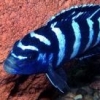Pictures

C. Frontosa Blue mpimbwe

C. Frontosa Burundi

Blue zambia

C. frontosa mpimbwe blue

Cyphotilapia Frontosa Blue Zaire 'Kitumba'
Description
Variants:
Burundi, moba, zaire, Mpimbwe, Kitumba, seven stripe Kigoma, and many others.
In the wild:
In nature C. frontosa is primarily living of fish. Highlights of Cyprichromis types. It does not hunt its food. However, using a more energy efficient method. It starts its search for food while it is still dark, and its prey is fish sleeping on the bottom and rocks. Then it will quietly swallow its prey.
In nature, C. frontosa swims in groups. These can easily contain more males and nesting females.
In the aquarium:
In the aquarium is C. frontosa easy to deal with. It is very robust, and rarely sick. However, there seemed to be some problems with wild caught specimens with air in the stomach / gut. In this way, they get up near the surface of the water and must constantly struggle to keep it self down.
This can be remedied with an intervention. You should be very inside the fish's anatomy, before heading into this.
A little history:
C. frontosa is one of the larger cichlids from Lake Tanganyika, where it is endemic. It lives on a fairly large depth. It is following caught as low as 70 meters.
It becomes large. For the main types are (Burundi variant) it up to 35 cm. Under aquarium terms on individuals of up to 45cm. However, this is not documented.
The species live in the lake's rocky areas at depths ranging from 10 meters to less than 100 meters. Although the species is prey living is too slow to catch its prey by hunting. Instead foraging the early morning when most other species are still inactive, here the so quietly gather his prey up on the bottom. It is particularly Cyprichromis are picked up, also, the food is also of shrimp and other large invertebrates. The species is maternal mouthbrooder, the kids are only fully developed after approx. 5 weeks of incubation. The species is, as I said maternal mouthbrooder, but there are a few (aquarist) cases observed biparental behavior (pers. Comm N. Ventzel 2008) - which is blah. Also a video of this phenomenon youtoube. C. frontosa can be kept in pairs but works best in groups of min. 6-7 fish - the larger specimens it is an advantage that there are too many males unless the aquarium is really big. This species is in many Tanganyika aquarists eyes one of the very finest. It has a lovely quiet temperament, but during play the alpha male good push something around with the other fellow residents. It may therefore be necessary to build up the aquarium so that the fish have anything (rocks, plants, etc..) To swim around so that they can escape - out of sight, out of mind. Are there ways to escape, the lower ranking individuals at risk of being pushed into a corner, moreover it is also necessary to mouth brooding females have some caves to stand in - otherwise the risk is that the other individuals can stress them. One consequence may be that they lose the eggs again. Suitable foods: Krill, shrimp, black gnats, mosquitoes white, daphnia, shrimp, fish, flakes, granules. Aquarium size (indicative, can vary from fish to fish): The young fish from 8cm. and up to 12 cm. Can a 325 ltrs. aquarium well used, but as soon as the fish reach sexual maturity should be 500 liters to a minimum. When an adult flock fish in sizes of 15 - 25 cm. Should a 720 liter aquarium to a minimum. Individuals of 25 - 35 cm long. should have very large aquariums.
Breeding Behaviour:
C. frontosa is just as calm when it breeds, such as when it is doing everything else. The male dampens its color and lays its fins down, not to scare the female. Then he tries to identify her for a predetermined area. This phase can take a very long time. Personally, I have experienced it went on for more than 14 days before she was ready. The male was not at any time, impatient or violent to her. When she finally is ready, depositing an egg, which she immediately takes in the mouth. The male attaches itself then on the side, quivering slightly and releases his sperm. This the female takes in the mouth and start over. It is only the female takes care of mouthbrooding.
Number of offspring
40
Info
Type
Cichlids, Tanganyika - Hap
Trade Name
Cichlids, Tanganyika - Hap
Trade Name
Tanganyika Humphead, Gente Giant
Described
Boulenger 1906Looks
Colours
The basic color of the frontosa are white and black / dark blue. It always has 6 vertical bands of dark blue / black. However, with the exception of Kigoma variant. It has 7 Depending catch variant, the blue color more or less intense. The front band is also varying in accordance with variant. In Burundi type, exists a nearly vertical front band. Where in Mpimbwe variant, almost forming a mask in front of their eyes, and further down over his head.
Size Male
35
Size Female
22
Best Conditions
The basic color of the frontosa are white and black / dark blue. It always has 6 vertical bands of dark blue / black. However, with the exception of Kigoma variant. It has 7 Depending catch variant, the blue color more or less intense. The front band is also varying in accordance with variant. In Burundi type, exists a nearly vertical front band. Where in Mpimbwe variant, almost forming a mask in front of their eyes, and further down over his head.
Size Male
35
Size Female
22
Best Conditions
Min. temp
23°C
Max. temp
27°C
Min. pH
7.5
Max. pH
8.5
Min. aquarium
530L
Holding!;
Pack
23°C
Max. temp
27°C
Min. pH
7.5
Max. pH
8.5
Min. aquarium
530L
Holding!;
Pack
Food
Food:
- Artemia
- Cichlid Sticks
- Flakes
- Krill
- Living Food












